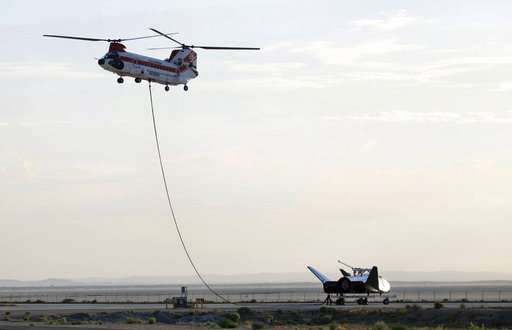Dream Chaser spacecraft in captive-carry test over desert

A test version of a spacecraft resembling a mini space shuttle was carried aloft over the Mojave Desert by a helicopter Wednesday in a precursor to a free flight in which it will be released to autonomously land on a runway as it would in a return from orbit.
Sierra Nevada Corp.'s Dream Chaser craft was lifted off the ground at 7:21 a.m., at NASA's Armstrong Flight Research Center on Edwards Air Force Base, California, and was carried to the same altitude and flight conditions it will experience before release in a free flight.
A control team sent commands to the wingless vehicle and collected data before the helicopter brought it down at 9:02 a.m., the company said.
"Everything we have seen points to a successful test with useful data for the next round of testing," director of flight operations Lee "Bru" Archambault said in a statement.
A second captive-carry test is scheduled this year and if it is successful, a free flight test will follow.
The Dream Chaser is being developed to carry cargo to and from the International Space Station without a crew aboard. The version flown Wednesday is for tests in the atmosphere. The version that will be launched into space is still in development.
With the addition of life-support equipment, a Dream Chaser could transport a crew of seven.
Last month, Sierra Nevada selected United Launch Alliance's Atlas 5 rocket to launch the first two Dream Chaser cargo missions, which are scheduled to blast off from Cape Canaveral, Florida, in 2020 and 2021. Those missions will land at Kennedy Space Center.
The Dream Chaser is a type of craft known as a "lifting body" in which aerodynamic lift is generated by its shape rather than wings like those of a conventional aircraft. Tail fins angling upward at the rear of the craft provide control.
NASA proved the lifting body concept by flying a series of wingless aircraft at Edwards in the 1960s and '70s.
The Dream Chaser is 30 feet (9 meters) long, about one quarter the length of a space shuttle.
Sierra Nevada is headquartered in Sparks, Nevada, and the Dream Chaser is being developed by the company's Louisville, Colorado-based Space Systems business.
© 2017 The Associated Press. All rights reserved.



















